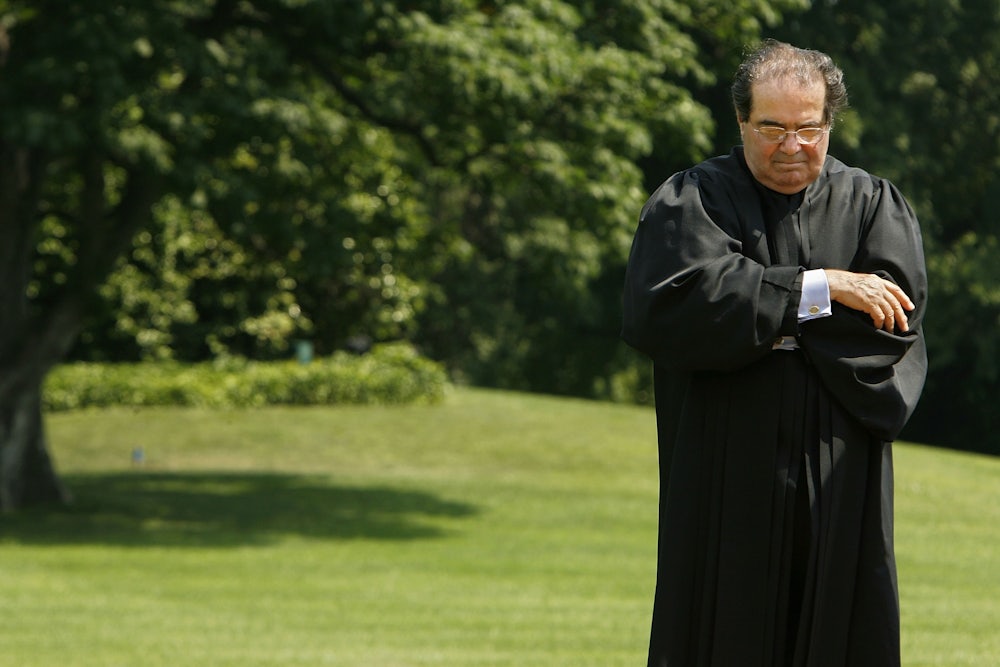Antonin Scalia, the recently deceased Supreme Court justice, leaves a complicated legacy behind him. Going forward, what matters most is that he was a generally (though not perfectly) reliable vote for the conservative faction on the Court. Scalia’s sudden death effectively ends a long era of the Court being controlled by Republicans, and marks the beginning of a new age in which the politics of Supreme Court nominations will be increasingly fraught.
President Barack Obama will—and should—nominate a replacement. But it is clear that he or she will not be confirmed by the Republican-controlled Senate. The Republican leadership is not even pretending that it will consider the merits of any individual nominee.
This is clearly a setback for Democrats who have long wished to flip the ideological balance of the Court. Democrats should use this nomination fight to tilt the politics in their favor: by painting the Republicans as obstructionists, pointing out that the “tradition” of refusing to confirm Supreme Court justices in an election year is fictitious, and appealing to political constituencies who would like to see an individual nominee confirmed.
Still, even if Democrats convince voters of their cause and prevail in an ideal scenario of winning both the Senate and the White House in 2016, the trend lines marked by Scalia’s death point to greater polarization and less consensus, not only in Congress, but in the Court itself.
The refusal of Senate Republicans to even consider any Obama nominee may improve the odds that Democrats will retain the White House and retake the Senate, but neither of those outcomes are close to guaranteed. And how long there will be a vacancy on the Court will, of course, depend on how the elections play out. So let’s game out the various scenarios.
It is probable, though not certain, that if Republicans capture the White House they will carry the Senate. In this case, the president will be able to get a nominee confirmed, even if this means ending the option of using a filibuster for Supreme Court nominations. A slim Democratic majority would probably eventually confirm a Republican nominee, although not an obvious radical like Janice Rogers Brown, due to structural factors that make Democratic majorities reliant on red- or purple-state Democrats.
One wild card is the identity of the hypothetical Republican president. Ted Cruz or Marco Rubio would presumably attempt to nominate an orthodox conservative like Samuel Alito, making conflict with a Democratic Senate more likely. If Donald Trump is president, nobody knows what kind of justice he would nominate.
If Hillary Clinton or Bernie Sanders is inaugurated next January, everything will depend on control of the Senate. Should Democrats get it back, it is probable that attempts by the Republican minority to serially filibuster nominees would lead to the elimination of the filibuster for Supreme Court nominations, just as it was for all other federal judicial appointments.
If President Clinton or Sanders faces a Republican-controlled Senate, though, all bets are off. The conventional wisdom is that Republicans will simply not be able to institute a blanket ban on Democratic nominees. Supreme Court nominations will have been unusually central to the recently completed election, and Clinton or Sanders would claim a mandate to appoint Scalia’s replacement. Pressure from the media, voters, and probably other justices would mount, leading a handful of blue-state Republican senators to defect.
This is certainly possible, but it would be foolish to simply assume that it will happen. A “mandate” is not actually some magic source of power—a president’s mandate on Supreme Court appointments is what the Senate says it is. Marginal Republicans will face powerful countervailing pressures from congressional colleagues, interest groups, and base voters. Any Republican senator who votes to put a liberal on the Supreme Court would almost certainly face a fierce primary challenge.
Serially obstructing Supreme Court nominees would probably be bad for the popularity of the Republican Party, but senators are surely aware of the paradox demonstrated in 2012 and 2014: Actions that are bad for the Republican Party as a whole aren’t necessarily bad for individual Republican members of Congress.
This would, in other words, be simply uncharted territory. Anyone who has watched Senate Republicans perfect constitutional hardball cannot have any certainty that they will adhere to previous norms and prevent a vacancy from persisting for years.
Even if a constitutional crisis is averted in 2017 by either one party controlling both the White House and Senate or a Senate majority acquiescing to a president of the opposite party, a breakdown in the Supreme Court nomination process is almost certainly coming down the road. The advice and consent process established by the Constitution isn’t well adapted to disciplined, ideologically cohesive parties, and the evolution in partisan configuration will have mutually reinforcing effects.
The Supreme Court has typically been a centrist institution, and since early in the Nixon administration the typical median vote on the Court on politically salient issues has been a country-club Republican: Potter Stewart, Lewis Powell, Sandra Day O’Connor, and/or Anthony Kennedy.
But as the University of Maryland legal scholar Mark Graber argued in an important recent paper, there is nothing natural or inevitable about this. The typical centrism of the Court was driven by two factors—ideologically heterogeneous parties and relative elite consensus—that have vanished. Moderate Republicans will not control the Court, because for all intents and purposes they no longer exist. For the foreseeable future, the median vote on the Court will reliably vote with the liberal or conservative faction on politically salient issues, and the gap between liberal and conservative constitutional visions is likely to get wider.
As the stakes of Supreme Court nominations get ever higher, getting Court vacancies filled during periods of divided government is going to become increasingly difficult. Depending on the results of the 2016 elections, this dysfunctional future could very soon become our present.
